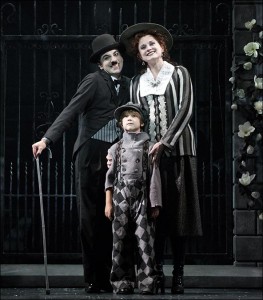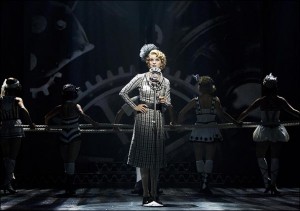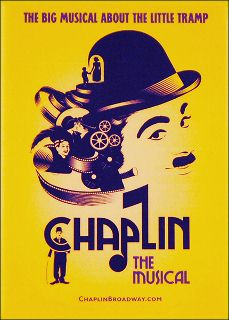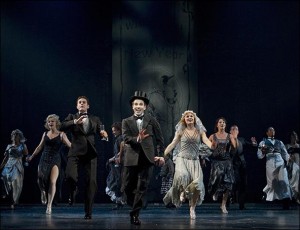WHAT’CHA GONNA DO?
In a poignant moment in Act II of the new musical Chaplin, cultural icon Charlie Chaplin realizes that life is not a movie. One has to take the tears with the laughter, and there is no guarantee of a happy ending. As it turns out, life is not really a musical either. Chaplin’s biography makes for a sprawling new show that never finds coherent form, despite compelling performances and a sweeping Hollywood style.
Charlie Chaplin’s beloved onscreen persona and tumultuous personal life seem ripe for theatrical interpretation, and this new musical aims to reveal the flesh and blood behind The Little Tramp who revolutionized silent film. In the striking opening image of the show, Chaplin teeters on a tightrope – perhaps walking a fine line between his private and public life, between his everyday existence and his iconic character. Rob McClure brings a boyish delight to the Little Tramp. Swinging his cane and shuffling down the street, tipping his bowler hat at the ladies, flashing a grin beneath his iconic moustache, he replicates Chaplin’s expressive physicality with charm and panache. Yet Chaplin is haunted by childhood memories – related in inconsistent flashback scenes with his mother, a structural device that is dropped in Act II – and struggles to maintain meaningful personal relationships amidst his rapid rise to fame.
 McClure’s nuanced performance is the glue in a musical that otherwise flies apart in every direction. Christopher Curtis and Thomas Meehan’s sprawling book dramatizes all the major events on the timeline of Chaplin’s life – and then some. The musical careens from his boyhood to his first Hollywood film, from a Look-a-Like contest at the peak of his career to his exile; the book could benefit from a consistent concept to provide connective tissue, or perhaps simply a more focused time frame. Even as the plot moves by leaps and bounds, the story sometimes feels at a standstill due to repetitive music. Curtis’ compositions are tuneful, but they often lack a hook. The chorus’ “What’cha gonna do when it all falls down?” is the most memorable mantra of the show – and, unfortunately, the talented cast and crew of Chaplin might be asking themselves this very question in a short matter of time.
McClure’s nuanced performance is the glue in a musical that otherwise flies apart in every direction. Christopher Curtis and Thomas Meehan’s sprawling book dramatizes all the major events on the timeline of Chaplin’s life – and then some. The musical careens from his boyhood to his first Hollywood film, from a Look-a-Like contest at the peak of his career to his exile; the book could benefit from a consistent concept to provide connective tissue, or perhaps simply a more focused time frame. Even as the plot moves by leaps and bounds, the story sometimes feels at a standstill due to repetitive music. Curtis’ compositions are tuneful, but they often lack a hook. The chorus’ “What’cha gonna do when it all falls down?” is the most memorable mantra of the show – and, unfortunately, the talented cast and crew of Chaplin might be asking themselves this very question in a short matter of time.
Rob McClure and the supporting cast give their all in this new musical. Christiane Noll’s silky soprano soars in the role of Chaplin’s mother; the gentle Erin Mackey deserves more stage time and character development as the love of Chaplin’s life,  Oona; and Jenn Colella’s star turn as conniving journalist Hedda Hopper may strike an inconsistent tone in the show, but her big number is a welcome showstopper in Act II.
Oona; and Jenn Colella’s star turn as conniving journalist Hedda Hopper may strike an inconsistent tone in the show, but her big number is a welcome showstopper in Act II.
In addition to its stellar cast, Chaplin showcases classy old Hollywood style. Jon Driscoll’s video and projection design illuminates the magic behind the movies, which are often simultaneously reproduced live on stage. Warren Carlyle’s direction weaves Charlie Chaplin in and out of the silent film screen, from madcap farce on Chaplin’s first day in the studio to intimate close-ups of The Kid in tears. The black-and-white color palette of Beowulf Boritt’s sets and Amy Clark and Martin Pakledinaz’s costumes paint a stunning silent film grain onto the show; the color scheme sets a dark, almost Dickensian tone for Chaplin’s life, and then a hint of Tim Burtonesque fantasy as the life that Chaplin wished for becomes real.
Yet a striking aesthetic and strong performances are not enough to buoy this production. As Charlie Chaplin himself knew, artistic creation takes time – and Chaplin still needs development.
photos by Joan Marcus
Chaplin
Ethel Barrymore Theatre in New York City
scheduled to close on January 6, 2013
for tickets, call 212-239-6200 or visit http://www.chaplinbroadway.com


{ 1 comment… read it below or add one }
“Compelling performances,” “sweeping Hollywood style,” “striking opening image,” “McClure’s nuanced performance,” “plot moves by leaps and bunds,” “Curtis’ compositions are tuneful,” “talented cast and crew,” “supporting cast gives their all,” “Christiane Noll’s silky soprano,” “Jenn Colella’s big number is a welcome showstopper,” “stellar cast,” “showcases classy Hollywood style,” “sets and costumes paint a stunning silent film grain into the show,” “striking aesthetic,” and “strong performances.”
Sound familiar? All these words are found in the article. Clearly the show is worth seeing for any number of reasons. Why, oh why, couldn’t the writer say so? I saw the same show and noticed the same things. It’s all in the spin you put on it.
P.S. No mention of rhe fabulous lighting by Ken Billington that raises the show to a whole new level?